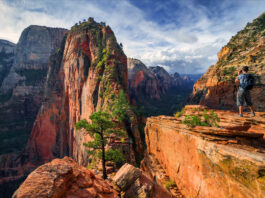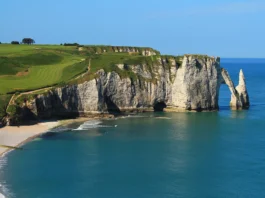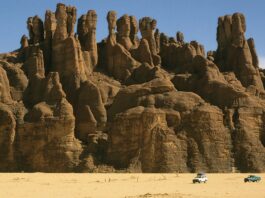Black Sand Beach, also known as Reynisfjara Beach, is one of Iceland’s most iconic and mesmerizing natural attractions. As the name suggests, this beach is renowned for its distinctive jet-black volcanic sand, dramatic basalt columns, and stunning coastal scenery. It is a place where the raw forces of nature are on full display, making it a must-visit destination for travelers exploring Iceland’s unique landscapes.



Location: Black Sand Beach is situated on the southern coast of Iceland, near the small village of Vík í Mýrdal. It is part of the larger Reynisfjara area, which is characterized by its black sand shoreline, rugged cliffs, and towering basalt columns. This captivating beach is approximately 180 kilometers (112 miles) southeast of Reykjavik, Iceland’s capital city, making it easily accessible for tourists exploring the country’s southern region.

Geological Significance: The black sand of Reynisfjara Beach is the result of volcanic activity in Iceland. The sand is composed of tiny fragments of lava, created when molten rock from volcanic eruptions rapidly cools upon contact with the ocean water. This unique geological feature gives the beach its otherworldly appearance and sets it apart from typical sandy shores.
Basalt Columns: One of the most striking features of Black Sand Beach is the towering basalt columns that line the cliffs. These hexagonal-shaped columns, known as Reynisdrangar, are a natural wonder formed by the cooling and contracting of lava flows. They add an eerie and fantastical quality to the landscape, making it a popular spot for photographers and nature enthusiasts.
Bird Watching: Reynisfjara Beach is also significant for its birdwatching opportunities. The cliffs provide nesting grounds for various seabirds, including puffins during the summer months. Birdwatchers often visit the area to observe these fascinating creatures in their natural habitat.
Safety Precautions: It’s important to note that while Black Sand Beach is a stunning destination, it can also be dangerous due to powerful waves and unpredictable currents. Visitors are advised to exercise caution and respect all safety warnings and guidelines provided in the area to ensure a safe and enjoyable visit.
In conclusion, Black Sand Beach in Iceland is a remarkable natural wonder known for its unique black volcanic sand, basalt columns, and stunning coastal beauty. Its geological significance, along with its proximity to other notable attractions in the southern region of Iceland, makes it a must-visit location for travelers looking to experience the raw beauty of this volcanic island.
Geological Formation

The black sand found at Black Sand Beach (Reynisfjara Beach) in Iceland is a result of its volcanic origins and is accompanied by unique geological features. Here’s an explanation of the formation of the black sand and the associated volcanic features:
Volcanic Origins: Iceland is often referred to as the “Land of Fire and Ice” due to its location on the Mid-Atlantic Ridge, a tectonic boundary where the Eurasian and North American plates meet. This geological setting makes Iceland highly active in terms of volcanic activity. Many of the island’s iconic features, including its black sand beaches, are a direct result of volcanic processes.
Formation of Black Sand: The black sand at Reynisfjara Beach is primarily composed of tiny fragments of volcanic rock. This volcanic rock is created during volcanic eruptions when molten lava is ejected from volcanoes and comes into contact with cold seawater or air. The rapid cooling of the lava causes it to solidify quickly and shatter into small fragments. These fragments, made up of various minerals and volcanic materials, are what make up the black sand.
Composition of Black Sand:The black sand at Reynisfjara Beach in Iceland is primarily composed of basalt, a type of volcanic rock, and contains several key mineral components. Here is the composition of the black sand at Reynisfjara:
- Basaltic Minerals: The dominant mineral in the black sand at Reynisfjara is basalt. Basalt is rich in several minerals, including:
- Pyroxenes: These minerals, such as augite and hypersthene, are common in basalt and contribute to its dark color.
- Olivine: Another common mineral in basalt, olivine can vary in color from green to black and is a significant component of the sand.
- Plagioclase Feldspar: This mineral group includes minerals like labradorite and bytownite and is often present in basaltic rocks.
- Iron-Rich Minerals: Iron is a crucial element in the formation of the black sand’s dark color. Iron-rich minerals, including magnetite and ilmenite, are present in varying amounts in the basaltic rocks and contribute to the sand’s black hue.
- Other Volcanic Materials: In addition to the primary mineral components, the black sand may also contain other volcanic materials, such as:
The specific mineral composition of the black sand at Reynisfjara is influenced by the geological history and characteristics of the volcanic eruptions that have occurred in the region. The dark color of the sand is primarily due to the presence of iron-rich minerals, which oxidize when exposed to air and turn black.
Basalt Columns: One of the most distinctive geological features at Black Sand Beach is the presence of basalt columns. These columns are created from basaltic lava flows. When lava flows cool, they contract and crack in a hexagonal pattern, forming the characteristic geometric columns seen along the beach. These columns, known as Reynisdrangar, not only add to the beach’s unique appearance but also provide a glimpse into the volcanic history of the area.
Volcanic Activity: Iceland’s proximity to the Mid-Atlantic Ridge makes it a hotspot for volcanic activity. The island boasts numerous volcanoes, both active and dormant. Eruptions, whether subglacial or subaerial, have played a crucial role in shaping the landscape over millions of years. The volcanic activity is responsible for the constant renewal of the black sand on Reynisfjara Beach as new volcanic eruptions occur and add fresh layers of lava and ash to the coastline.
Geological Diversity: In addition to the black sand and basalt columns, Reynisfjara Beach features other geological formations such as sea stacks, caves, and towering cliffs. These formations are the result of the complex interplay between volcanic activity, erosion by ocean waves, and the unique geological characteristics of the area.
In summary, the black sand at Black Sand Beach in Iceland is a product of volcanic origins, formed by the rapid cooling and fragmentation of lava during volcanic eruptions. The presence of basalt columns, sea stacks, and other geological features on the beach adds to its unique and otherworldly appearance, highlighting the dynamic geological processes that have shaped this captivating landscape over millions of years.
Natural Attractions
Reynisfjara Beach and its surroundings in Iceland are a treasure trove of natural attractions, featuring basalt columns, sea stacks, caves, and a diverse range of wildlife. Here’s an overview of these remarkable elements:

Basalt Columns: Reynisfjara Beach is famous for its striking basalt columns, which are natural geological formations. These columns are created when basaltic lava flows cool and contract, causing the lava to crack and form hexagonal shapes. The columns at Reynisfjara are not only visually captivating but also offer visitors a unique opportunity to witness the incredible power of geological processes. They line the cliffs near the beach and create a surreal and almost otherworldly atmosphere.

Sea Stacks: The beach is adorned with imposing sea stacks rising dramatically from the ocean. One of the most famous sea stacks in the area is called Reynisdrangar. These sea stacks are remnants of eroded cliffs and volcanic activity, and their jagged, towering forms provide a stunning contrast to the black sand beach and the surrounding ocean. Reynisdrangar, in particular, has an intriguing folklore associated with it, adding to its mystique in Icelandic culture.

Caves: Reynisfjara Beach is also home to several caves, including Hálsanefshellir and other smaller formations. These caves are formed through a combination of volcanic activity and the relentless force of the ocean’s waves. While some of these caves are easily accessible, exploring them should be done with caution and preferably with a local guide due to the potential dangers posed by the changing tides and waves.
Wildlife in the Area: The cliffs surrounding Reynisfjara Beach serve as nesting sites for various seabird species. During the summer months, birdwatchers can observe puffins, guillemots, and kittiwakes as they make their nests and rear their chicks. The sight of these birds soaring above the cliffs and diving into the ocean for food is a thrilling experience for nature enthusiasts.Additionally, the waters around Reynisfjara Beach are inhabited by marine life, and visitors might spot seals and even whales in the distance. The combination of the rugged coastline, dark sand, and abundant wildlife makes this area a haven for photographers and wildlife enthusiasts alike.
In conclusion, Reynisfjara Beach and its surroundings in Iceland offer a captivating array of natural attractions, including basalt columns, sea stacks, caves, and a vibrant array of wildlife. These elements come together to create a unique and enchanting coastal environment, making it a must-visit destination for those seeking to immerse themselves in the raw beauty of Iceland’s southern coast. However, it’s important for visitors to respect the natural environment and wildlife and to exercise caution, especially near the water and cliffs.
Tourism and Visitor Experience

Tourism at Reynisfjara Beach and its surrounding area in Iceland has grown significantly in recent years due to its stunning natural attractions and unique geological features. Here’s a look at the visitor experience and the impact of tourism on the area:
- Spectacular Scenery: Reynisfjara Beach offers visitors a chance to experience some of Iceland’s most dramatic and visually striking landscapes. The combination of the black sand, basalt columns, sea stacks, and caves creates a surreal and awe-inspiring environment that is a photographer’s dream and a nature lover’s paradise.
- Accessibility: The beach is relatively easy to access, located just a short drive from the village of Vík í Mýrdal on Iceland’s Ring Road. This accessibility has made it a popular stop for tourists traveling along the southern coast of Iceland.
- Safety Precautions: Due to the powerful waves and unpredictable currents in the area, it’s crucial for visitors to heed safety warnings and guidelines. Tragically, accidents have occurred at Reynisfjara Beach, highlighting the importance of respecting the natural forces at play. Many local tour operators provide guided tours that prioritize safety and educate visitors about potential hazards.
- Local Tours: Tour operators in the area offer guided excursions, which can enhance the visitor experience. These tours often provide insights into the geological history of the beach, the folklore associated with it, and opportunities to explore nearby caves and cliffs while ensuring safety.
- Birdwatching: For bird enthusiasts, Reynisfjara Beach is an excellent place to observe seabirds, especially during the summer months when puffins and other species nest in the cliffs. Guided birdwatching tours are available for those looking to learn more about the avian life in the area.
- Cultural Significance: The area is steeped in Icelandic folklore and legends, adding cultural depth to the visitor experience. Local guides often share stories and myths associated with Reynisfjara and its geological formations.
- Impact of Tourism: While tourism has brought economic benefits to the region, it has also raised concerns about environmental conservation and sustainability. Increased foot traffic and visitor numbers can have an impact on the fragile ecosystem and geological features. Conservation efforts and responsible tourism practices are essential to protect the area for future generations.
- Infrastructure: Over the years, there have been improvements in infrastructure at Reynisfjara Beach, including the addition of parking facilities, viewing platforms, and informational signs. These enhancements aim to enhance the visitor experience while minimizing the impact on the environment.
In conclusion, Reynisfjara Beach offers a remarkable visitor experience, combining breathtaking natural beauty with geological wonders and cultural significance. While tourism has undoubtedly brought attention and economic benefits to the area, it is essential for visitors and local authorities to prioritize safety, environmental conservation, and responsible tourism practices to ensure that this unique destination remains accessible and pristine for generations to come.






